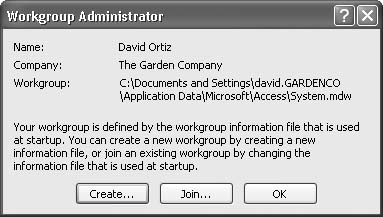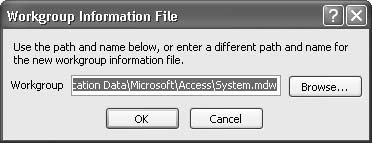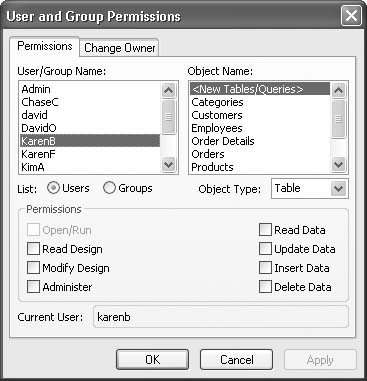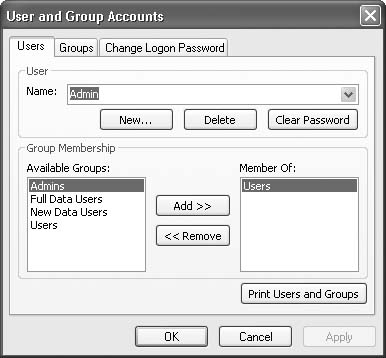When you want to secure a multi-user database, the Security Wizard guides you through the process of creating a workgroup, adding groups and users, and assigning passwords and permissions. After the workgroup has been created, you can either use workgroup commands to maintain it or run the wizard again to modify the WIF.
The following workgroup commands are grouped together on the Security submenu of the Tools menu:
Command | Purpose |
|---|---|
Workgroup Administrator | Change the current workgroup. |
User and Group Permissions | Change the permissions that groups or users have for all database objects. |
User and Group Accounts | Add and delete users and groups. Assign users to groups. Clear any password or change the logon password for the user currently logged on. |
User-Level Security Wizard | Create and modify workgroups. |
What users can do with these commands is determined by their permissions.
In this exercise, you will explore these commands and change a user password. To complete this exercise, you must have first worked through the previous exercise.
BE SURE TO complete the previous exercise before beginning this one. Start Access before beginning this exercise, but don’t open the GardenCo database yet.
USE the GardenCo database and the Security workgroup information file from the previous exercise for this topic. These practice files are located in the My DocumentsMicrosoft PressAccess 2003 SBSSecureMulti folder and can also be accessed by clicking Start/All Programs/Microsoft Press/Access 2003 Step by Step.
Try to open the GardenCo database by clicking the Open button on the Access toolbar, navigating to the My DocumentsMicrosoft PressAccess 2003 SBSSecureMulti folder, and double-clicking GardenCo.
A message appears, telling you that you don’t have the permissions necessary to open this database.
Click OK.
Access remains on your screen, but no database is open.
On the Tools menu, point to Security, and then click Workgroup Administrator to open the dialog box.
Write down the name and path of the current workgroup. You will need this information later.
Click Join.
The Workgroup Information File dialog box appears.
Click Browse, navigate to the My DocumentsMicrosoft PressAccess 2003 SBSSecureMulti folder, select Security (this WIF file was already created and named by the wizard), and click Open.
Click OK to accept the path and name for the selected WIF.
An alert box informs you that you have joined the selected workgroup.
Click OK to close the alert box, and click OK again to close the Workgroup Administrator dialog box.
Try again to open GardenCo by double-clicking its file name in the practice file folder.
This time, Access displays the Logon dialog box.
In the Name box, type
KarenB, and then in the Password box, typepw0. Click OK.The database opens.
Important
Access to different secured databases can be controlled by different WIFs, and you can have multiple WIFs on one computer. However, only one workgroup can be active on a computer at any time. After you join a workgroup, you remain in that workgroup until you join a different one. The current workgroup is stored in the computer’s registry as an attribute of Access. Because this workgroup requires users to log on, any user trying to open any Access database from this computer will be asked for a user name and password. (A user on a different computer could connect through the LAN and open any non-secured database stored on this computer without logging on, but that user could not open a secured database.)
On the Tools menu, point to Security, and click User and Group Permissions.
Any member of the Admins group can use this dialog box to set permissions for an individual user or a group. Permissions are set separately for each user and each object type. You select the user in the User/Group Name box, select the object in the Object Type drop-down list, and then select one or more of the objects of that type in the Object Name list. Finally, click each permission you want to assign.
In the List section, click Groups.
When this workgroup was created, permissions for groups were set and users were assigned to the groups. Users inherit the permissions of the groups they belong to, so this is a quick way to set permissions for several people at one time.
Click each group name, and watch the permissions change.
Note that New Data Users cannot modify table design.
Click Cancel to close this dialog box, and then quit Access.
Start Access again, and open the GardenCo database located in the practice file folder, this time logging on as
NancyAwith a password ofpw5. (Nancy is a member of the New Data Users group.)Attempt to open any table in Design view.
Access warns that you don’t have permission to modify the table and asks if you want to open it as read-only. You would see a similar message if you tried to delete a record, but not if you tried to add a record.
Click No to close the alert box, and then quit Access.
Start Access, and reopen the same database as
KarenB, with the passwordpw0.On the Tools menu, point to Security, and then click User and Group Accounts to display the dialog box.
As a member of the Admins group, Karen can add and remove users and groups. She can also clear the password of any user so that the user can log on and set a new password.
Click the Change Logon Password tab to display the options.
In the Old Password box, type
pw0(the current password), press , type
, type Nos27Len(the new password), press again, and verify the new password by typing it again. Then click OK.
again, and verify the new password by typing it again. Then click OK.The next time Karen logs on, she will have to use the new password.
On the Tools menu, point to Security, and then click User-Level Security Wizard.
You can use the wizard to modify the current workgroup. You can change anything you set when you used this wizard to create the workgroup, except the user names and passwords of existing users.
Click Cancel, and then quit Access.
Click Start, navigate to the My DocumentsMicrosoft PressAccess 2003 SBS folder, and try to open any non-secured database by double-clicking its file name in one of the subfolders.
Access prompts you to log on because the active workgroup requires it.
Click Cancel.
Navigate to the My DocumentsMicrosoft PressAccess 2003 SBSSecureMulti folder, and open the GardenCo database, logging on as
KarenBwith the new passwordNos27Len.On the Tools menu, point to Security, and then click Workgroup Administrator.
Troubleshooting
If you are using Microsoft Windows 2000 or Microsoft Windows XP, one of the folders in the path to your original workgroup might be hidden. To browse to it, you will have to set Windows Explorer to show hidden files and folders. To do this, start Windows Explorer, click Folder Options on the Tools menu, click the View tab, click "Show hidden files and folders", and click OK.
Click Join, click Browse, browse to the WIF whose name and path you wrote down in step 4, and click Open.
Click OK to close the Workgroup Information File dialog box, and click OK twice more to close the message box and the dialog box.
A message appears, informing you that you don’t have permission to open this database. (It is a secured database and you are no longer a part of its workgroup.)
Click OK, navigate to any of the My DocumentsMicrosoft PressAccess 2003 SBS practice file folders, and try to open one of the non-secured GardenCo databases.
The database opens without prompting you to log on because the default workgroup doesn’t require it.
CLOSE the GardenCo database.





